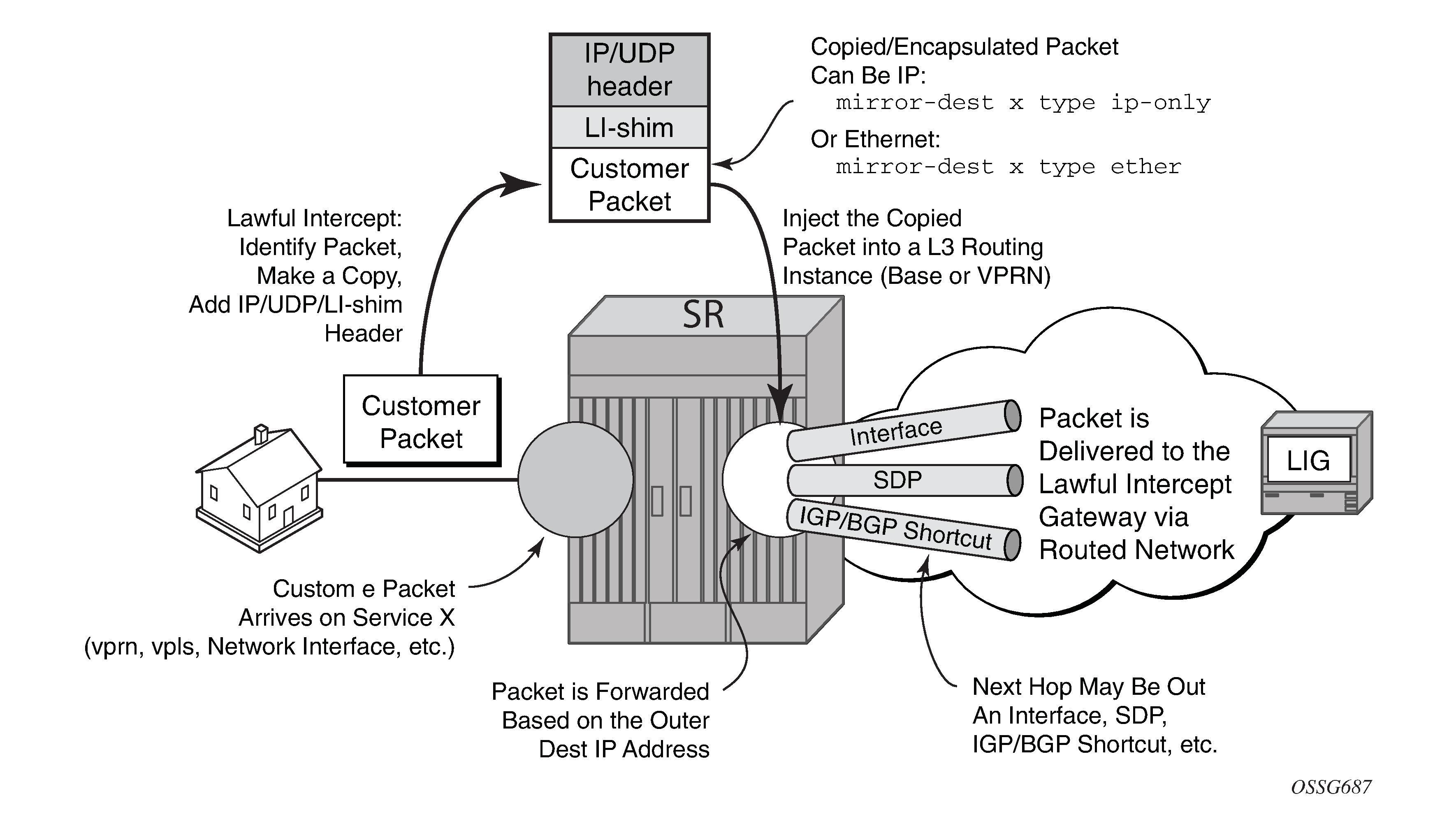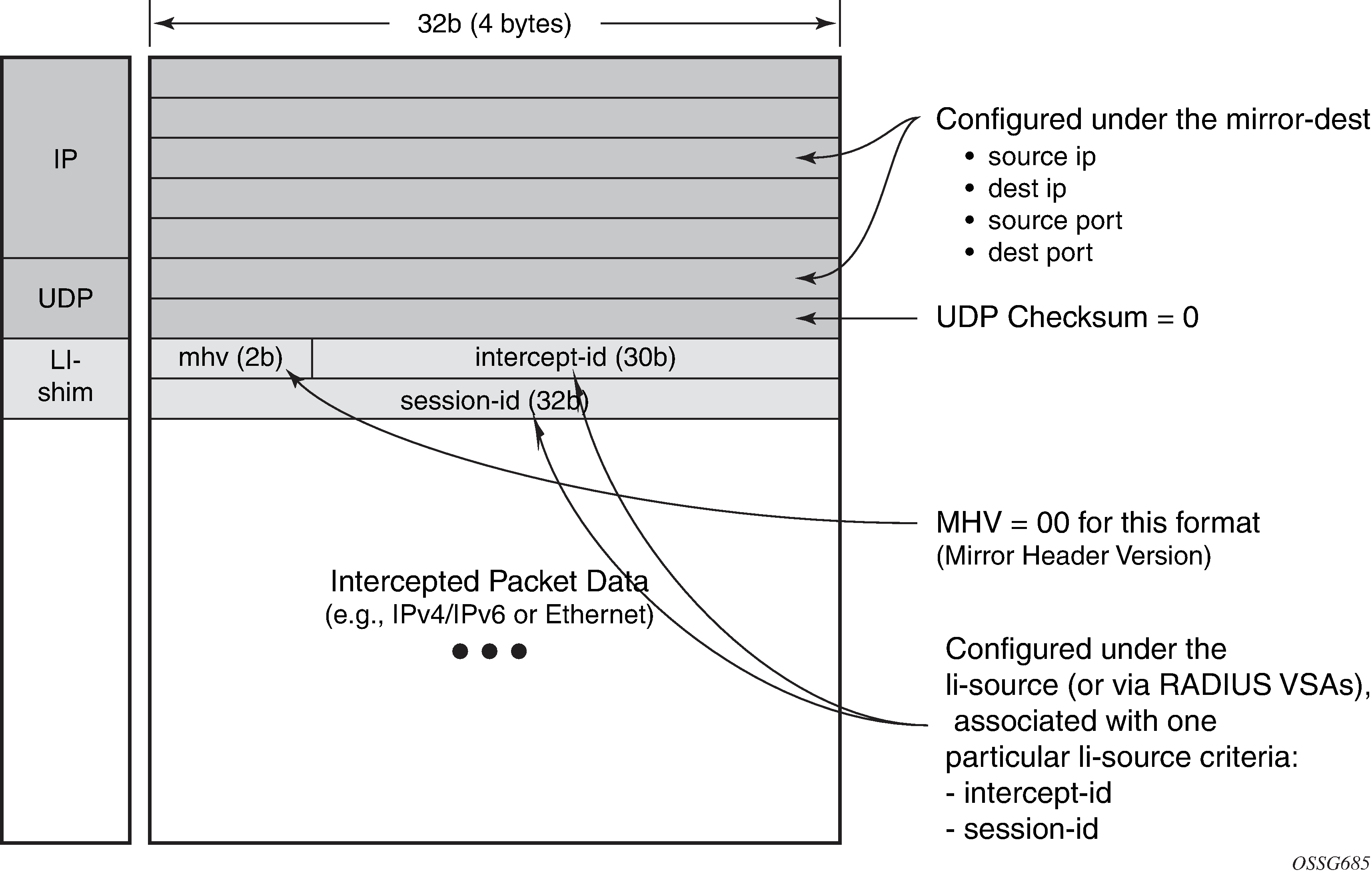The Routable LI encapsulation feature allows LI mirrored packets to be placed into a routable (for example, IP/UDP) header and then forwarded in a routing context (base or VPRN). An LI-shim inserted before the customer packet allows correlation of packets to LI sessions at the downstream LI Mediation device (LIG).


Some of the supported attributes and scenarios for the routable LI encapsulation feature include the following:
The part of the customer packet that is copied and placed into the routable encapsulation can be either the IP packet (with none of the original Layer2 encap) or an Ethernet packet by selecting either ip-only or ether as the mirror-dest type.
The ability to inject into the Base routing instance (for forwarding out network interfaces or IES SAPs for example) or a VPRN service.
The ability to forward the encapsulated packets out VPRN SDPs, IGP/BGP shortcuts and SDP spoke interfaces.
Options to use ip, udp, li-shim or ip, gre routable encapsulation (applies to the 7450 ESS and 7750 SR).
An optional direction bit in the li-shim; if the use of the direction bit is configured, then a bit from the intercept-id (configure under mirror-dest) is ‟stolen”. Only a 29b intercept-id is allowed for li-source entries if the mirror destination is configured to use a direction bit.
Figure: LI-shim version 01 with a direction bit
The encoding of the direction (d) bit is as follows:
0 = ingress
1 = egress
For NAT based LI, ingress means the traffic arriving at the node from the subscriber host (applies to the 7450 ESS and 7750 SR).
User configurable intercept-id and session-id per li-source entry that is placed into the li-shim (a total max of 62 configurable bits).
Configuration via CLI/SNMP or RADIUS (applies to the 7450 ESS and 7750 SR). For RADIUS configuration the following VSAs are used:
Alc-LI-Action, Alc-LI-Direction, Alc-LI-Destination, Alc-LI-FC (See LI activation through RADIUS).
Alc-LI-Intercept-Id specifies the intercept-id to place in the LI shim. Only applicable if the mirror-dest (as specified by the Alc-LI-Destination) is configured with routable encap that contains the LI-Shim. A value of 0 is used if this VSA is not present.
Alc-LI-Session-Id specifies the session-id to place in the LI-Shim. Only applicable if the mirror-dest (as specified by the Alc-LI-Destination) is configured with routable encap that contains the LI shim. A value of 0 is used if this VSA is not present.
A LI session configured via RADIUS takes precedence over a session configured via CLI, but the CLI mirror is re-instated if the RADIUS mirror request is later removed (applies to the 7450 ESS and 7750 SR)
ip, udp, and li-shim encap is available for ether and LI shim mirror-dest types.
- ip | udp | li-shim encap is available for all li-source entry types (sap, filter, subscriber and nat).Note: For NAT based Lawful Intercept, routable LI encap is available, as well as the MAC or Layer 2-based encapsulation for NAT LI as configured under config>li>li-source>nat>ethernet-encap (applies to the 7450 ESS and 7750 SR)
Fragmentation of the resulting mirror packet is supported. Note that fragmentation is supported for NAT LI with the routable encapsulation, but fragmentation is not supported for NAT LI with Ethernet encapsulation (applies to the 7450 ESS and 7750 SR).
The following restrictions apply to the routable LI encapsulation feature:
Only applicable to Lawful Intercept and is not available for debug or MS-ISA based Application Assurance mirrors. MS-ISA based Application Assurance is applicable to the 7450 ESS and 7750 SR.
Not applicable to PPP, SAToP, or CESoPSN mirror-dest types.
IPv4 transport only (the routable encapsulation cannot be IPv6).
On the mirror source node, forwarding of routable encapsulated LI packets out of an R-VPLS interface is not supported. A mirror destination configured with routable encapsulation can be bound to a routing instance that also has an R-VPLS bound to it, but the operator must ensure that the destination of the LI packets is not reachable via any R-VPLS interfaces. Any routable encapsulated LI packets that arrive at the egress of an R-VPLS interface are discarded. Parallel use of routable LI encapsulation and R-VPLS in the same routing instance is supported if the mirrored packets do not egress out of the R-VPLS interface.
ip | gre encap is supported for the ip-only mirror destination type only, and only for subscriber li-source entries (CLI, SNMP, or RADIUS based). Subscriber management is not supported on the 7950 XRS.
The contents of the GRE header are all zeros (all optional bits zero, no optional headers/fields like checksum, offset, key, seq, and so on) except for the Protocol field which contains 0x0800 for IPv4 packets or 0x86DD for IPv6 packets. The far-end receiver of the intercepted packets must be configured to expect no GRE options (that is, no key, no checksum, and so on).
On the source node where LI mirroring occurs, the operator must configure the mirror-dest to inject into the routing instance (that is, base or VPRN) in which the actual destination address is reachable without having to hop into a different instance using GRT leaking. In other words, the interface out, which the packet travels, must exist in the routing instance that is configured in the mirror-dest.
For example, if the LIG is at 110.120.130.140 and is in the base instance, but VPRN-1 has a default route to the GRT (for example, 0.0.0.0->GRT) then the operator must configure the mirror destination to inject into the base (even though theoretically address 110.120.130.140 is reachable from VPRN-1). If the operator attempts to configure the mirror destination to inject into VPRN-1, and VPRN-1 itself does not have reachability to 110.120.130.140 out an interface that is part of the VPRN, then the mirror destination is operationally down.
Care must be taken in the configuration of LI mirrors and the destination IP address for the routable LI encapsulation. Incorrect selection of the destination IP could send packets to unintended destinations (for example, configuring the encapsulation with a subscriber's IP address), and combinations of mirrors and routable encapsulation can create loops in the network.